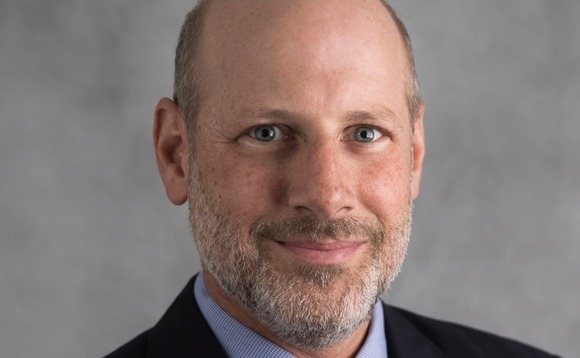
Q&A: Teacher Retirement System of Texas' Eric Lang

Eric Lang, senior managing director of external private markets at Teacher Retirement System of Texas (TRS), discusses co-investment, strategic partnerships, and Asian expansion plans
Q: How has the TRS private markets program evolved?
A: The long-term private markets allocation – which includes private equity, real estate, and energy, natural resources and infrastructure (ENRI) – is 35% of the trust. It is a substantial portfolio for a US public plan, and it has evolved over time, rising from around 9% in 2006. A reason for that is the trust believes it’s one of the few places we can deliver excess returns. We have dedicated substantial resources, for a US public plan, in order to do that. We launched an ambitious hiring program about 18 months ago – we call it ‘Building the Fleet’ – and we are around one-third through that. We have over 20 people in private equity, around 20 in real estate, and six in ENRI. We will continue to build these teams – the target for private equity is mid-30s – but we want to do it prudently and cautiously. We don’t want to bring in too many people at once. The growth in hiring is so we can do more principal investments. We have been doing these for 10 years and generated significant excess returns through fee savings and security selection.
Q: Are principal investments in private equity co-investments?
A: Most of them. Our program is a partner-based concept. We don’t want to compete with our general partners, we want to partner with them. We want to provide capital when they need it; we want to be alongside them, whether it be co-underwriting, a co-investment, or a fund investment. It’s in between the standard LP model and the Canadian model. Even though we have more resources than many US public plans, we don’t have enough resources to compete with PE firms. Also, we feel they bring value to transactions.
Q: Are you consolidating GP relationships?
A: We were originally an LP investor, then we moved to doing a few principal investments, we hired more staff, and we continue do more principal investments. Funds make up a smaller percentage of our portfolio and we are focusing on key partners, not really adding to our general partner list. There are quite a few relationships in total because we have a large non-active portfolio. Excluding those and there are around 40 GPs in the PE portfolio that we will continue to do business with. There are more in real estate because we have more specialist partners with separate accounts or single limited partner funds. For ENRI, we have half as many partners as in PE.
Q: How big are the commitments you make?
A: In 2018, we committed approximately $4.5 billion – $3 billion to funds, $1.3 billion to principal investments, and the rest to our emerging managers program. Fund investments are $100 million to $600 million and the average is probably around $200 million. For co-investment, we can go as high as we want, but the average is around $100 million. We have written checks as small as $50 million, but for significant buyout transaction it can be $200-$300 million. The largest is $300 million. We have an internal investment committee, of which I am a member, that can approve significant size investments and we do not come close to exceeding its approval authority. However, we have also set up asset class investment committees that can approve smaller transactions of $25-100 million. This has helped execute smaller investments. We continue to evolve to determine best practices, and I would say our approval process never gets in the way of us doing a transaction.
Q: Are you primarily recruiting people with direct investment experience?
A: Our goal is to increase our share of principal investments to funds – the overall private equity allocation will be pretty stable at around 14% – and to do that we need more people to underwrite those transactions. We’ve been successful in hiring quite a few people in the senior ranks who have direct investment experience. Most of the people we are now hiring are junior level analyst and associate types. We are also adding staff within the private markets group to provide support on data analytics and performance.
Q: How are you structured across fund and principal investments?
A: At the senior team level, we divide it up by funds and principal investments. Within the principal investments team, they are divided by sector. At the junior level we have generalists who might spend 75% of their time on principal investments and 25% on funds. We think it’s good for people to get a broad background and we are big believers in cross-training, giving people exposure to different parts of the private equity ecosystem. Someone hired as a principal investment specialist will work on a fund investment once or twice a year.
Q: Where do the strategic partnerships come into it?
A: We have a separate team that runs our strategic partnerships. They run our public strategic partnerships as well, so they are a hybrid. That team works closely with my team. They are responsible for the relationships, but we are responsible for any principal transactions that come through those relationships. And any fund investments are reviewed at our team meetings. On the private side, the firm-wide strategic partners are KKR and Apollo. However, at the team level, we have developed similar kinds of relationships called enterprise agreements. We started developing that in real estate and we have one across private markets now.
Q: What is the difference between a strategic partnership and an enterprise agreement?
A: Apollo and KKR are trust-wide relationships, whether it’s private equity, real estate, infrastructure or credit. We allocate capital and consult with the manager as to how it is deployed across different strategies. Enterprise agreements are similar in that we look at our overall relationship with managers and control allocation, but they are more asset specific. For example, our real estate team might have a key relationship with a firm that invests globally, we allocate $500 million and then pick our spots based on market opportunities. We get benefits through fee savings, deal flow and principal transactions.
Q: What cost savings have the strategic partnerships brought?
A: The savings are significant, but it’s not just about cost. It’s about collaboration, deal flow and market knowledge and information sharing. Fee savings are a benefit, but the greater benefit is getting to know the firms better, seeing deals early, spending time with them, and cross-training. We are looking to focus on key partners that can provide us with the best deal flow, but I don’t think we will enter into other firm-wide strategic relationships. Most likely, teams will develop relationships based on their own needs. Those needs are very different – and it depends on the partners’ needs as well.
Q: You described the TRS model as in between the standard LP model and the Canadian model. How Canadian could you become?
A: We don’t have the resources or agency structure of the Canadian funds, so we won’t copy their model. We feel our model works for us and provides us the net returns to compete with them. I am not sure if the Canadian model is the best way to generate the best returns
Q: Are there similarities between what TRS is doing and California State Teachers’ Retirement System’s (CalSTRS) collaborative model?
A: What CalSTRS is trying to do is similar to what we do; we could call ours a collaborative model as well. We collaborate and talk to them about best practices on a regular basis. For plans to move in this direction, they need to dedicate resources to the teams. You can’t do what we are doing without appropriate resources, and you have to walk before you run. We have an excellent board of trustees and we are transparent with them and talk to them regularly, in addition to the formal annual board meeting on the private portfolio.
Q: How do you approach Asia?
A: We started investing in Asia in the mid-2000s. We didn’t know enough about the market to pick our own spots, so we worked with some allocators and separate account providers and had them do some market mapping. We made a separate account commitment, but that ended six or seven years ago as we started investing directly in funds. We have five or six relationships, both buyout and growth equity, mostly pan-Asian funds. Our strategic partnerships have also helped because one of our partners has found success in the buyout space in Asia, so we have utilized them a lot and learned a lot from them as well. Asia is not a large part of our portfolio, but it is being maintained and growing. As a US dollar investor, our returns have served us better here than Asia, but we do believe in the growth of Asia we recognize the need to be there.
Q: Are you making co-investments?
A: We’ve done a few. We haven’t seen a significant amount of deal flow and we have only been investing in Asia for 10 years. We don’t want to do too much initial co-investing while we are still developing an understanding of the market.
Q: How do you get comfortable with the region from a risk-return perspective?
A: You look at the macro environment and the US has been on an exceptional run. But when we look at the future of Asia – the growth, the demographics – it gives us comfort that investment returns will hopefully be there. I’m always questioning the team about where we are getting the best returns and whether we are getting paid for the risk of being there. It’s all about getting paid for your risk and understanding the risk premium, if indeed. There should be a risk premium in certain markets in Asia.
Q: TRS is currently considering whether to open an office in Asia, which would be its second international base. If this happens, would you expect to invest more in the region?
A: I don’t know if it means we will be doing more. Eventually, it could mean that. But the one thing it does mean – assuming we do open the office – is we will be closer to the market, closer to the deals, closer to our general partners. Hopefully, this will make us better investors. I wouldn’t say there is mandate that we must do a certain number of principal transactions in Asia because we have an office there but that will evolve over time with more deal flow, as it has in London. Even then, we aren’t doing deals for the sake of it. While our deal flow has increased significantly through the London office, the number of deals completed has not because we haven’t seen the value of certain transactions. It’s made a great difference in terms of knowledge and being able to respond to opportunities faster. Our partners know we can attend a management meeting at 30 minutes' notice if it’s in London. An Asia office would focus on public markets as well as private markets. We have traders in Austin, Texas working at all hours of the night because they are covering the Asian markets. It makes sense to have some representation over there because of the 12-hour time difference. As such, an Asia office might help public markets sooner than it helps private markets.
Q: How do you feel about Asia in the context of toppy private markets globally?
A: As a global investor, we will always have investments in Asia, and we have a positive view on the region. I wouldn’t say we are bullish or bearish. We look for opportunities where we see value. Finding value isn’t easy, which is why we are building up our team and have our network of general partners. I don’t see how it doesn’t make anyone uncomfortable with more capital chasing the same deals, but that’s the reality. We must work harder, faster and smarter than others and find our spots. I am concerned by how much money is being raised, especially in the private equity world and how much dry powder there is in these vehicles. It is something we constantly monitor.
Latest News
Asian GPs slow implementation of ESG policies - survey
Asia-based private equity firms are assigning more dedicated resources to environment, social, and governance (ESG) programmes, but policy changes have slowed in the past 12 months, in part due to concerns raised internally and by LPs, according to a...
Singapore fintech start-up LXA gets $10m seed round
New Enterprise Associates (NEA) has led a USD 10m seed round for Singapore’s LXA, a financial technology start-up launched by a former Asia senior executive at The Blackstone Group.
India's InCred announces $60m round, claims unicorn status
Indian non-bank lender InCred Financial Services said it has received INR 5bn (USD 60m) at a valuation of at least USD 1bn from unnamed investors including “a global private equity fund.”
Insight leads $50m round for Australia's Roller
Insight Partners has led a USD 50m round for Australia’s Roller, a venue management software provider specializing in family fun parks.








